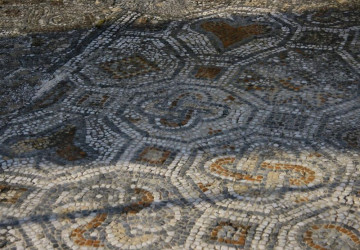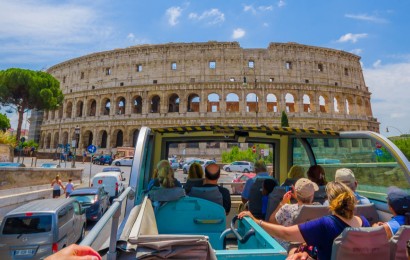Rome is a city that never ceases to amaze. Every corner hides a fragment of its millennia-old history, and among the most fascinating witnesses of its past are the Roman mosaics. These works, crafted with stone, glass, and marble tesserae, were not merely decorative elements; they told stories of daily life, myths, and religious symbols. Even today, while strolling through the Eternal City, you can admire stunning Roman mosaics in museums, churches, and even underground archaeological sites.
If you are wondering where to see Roman mosaics in Rome, this guide will take you through the most captivating places where they are preserved, with practical tips to enrich your visit.
The Best Roman Mosaics in Rome: Where to Find Them
The Roman Mosaics of the Capitoline Museums
An ideal starting point to admire Roman mosaics in Rome is the Capitoline Museums, located in Piazza del Campidoglio. Within their permanent collections, you will find mosaic floors originating from domus and villas of the imperial age.
Among the most famous is the Dove Mosaic, attributed to Sosos of Pergamon, depicting four birds drinking from a bowl. Discovered at Hadrian’s Villa in Tivoli, this masterpiece of technical refinement features shading and detail so delicate that the doves appear alive and in motion.
As you wander through the galleries, you can also admire other floor mosaics with geometric and figurative motifs, a testament to how widespread this decorative art was in Roman homes.
The Mosaics of the Vatican Museums
Those seeking a more comprehensive experience cannot miss the Vatican Museums, one of the most visited sites in Rome. Inside, you won’t only find Michelangelo’s frescoes in the Sistine Chapel but also extraordinary ancient mosaics.
The Gregorian Profane Museum houses mosaics from Roman necropolises and villas, many dating from the 2nd to 4th century AD. Some portray mythological scenes, while others depict marine motifs with fish and fantastic creatures, typical of thermal bath decorations.
A particularly striking spot is the Round Room, floored with a massive polychrome mosaic showing battles between centaurs and wild animals. Originating from an ancient Roman villa, its grandeur and vibrant colors make a powerful impression.
The Mosaic of the Baths of Caracalla
The Baths of Caracalla, built between 212 and 216 AD, were one of the largest and most luxurious bathing complexes of antiquity. Here, mosaics played a central role in decorating floors and spaces dedicated to relaxation and social gatherings.
One of the most famous is the Athletes Mosaic, now preserved in the Vatican Museums. It depicts wrestlers and boxers mid-combat, with remarkable realism that conveys both physical strength and competitive tension.
Walking among the imposing ruins of the baths, you can still spot fragments of original mosaics: black-and-white geometric designs that once adorned floors and corridors, testifying to the splendor of an age when art and daily life were deeply intertwined.
The Mosaics of Ostia Antica
For those willing to venture outside the city center, a visit to Ostia Antica is a must. Rome’s ancient port preserves extraordinary mosaics, many still in situ, offering insight into their use in both public and private spaces.
The Neptune Baths Mosaic, featuring sea deities, horses, and dolphins, is among the most spectacular and symbolically rich. Throughout the archaeological site, dozens of black-and-white mosaic floors remain, once decorating trade guild headquarters, baths, and homes.
Visiting Ostia Antica feels like stepping into an open-air museum, where mosaics narrate the daily life of a thriving, multicultural city.
Mosaics in Early Christian Churches
It is important to remember that Roman mosaics continued to evolve over the centuries, taking on new forms in Rome’s Early Christian basilicas.
In the Basilica of Santa Maria Maggiore, for example, you can admire magnificent 5th-century mosaics illustrating biblical scenes in a style that blends Roman heritage with Christian spirituality.
Another unmissable site is the Basilica of San Clemente, whose apse mosaics narrate the Triumph of the Cross with vivid and intricate imagery, symbolizing an art form that had acquired a theological role in addition to a decorative one.
Though later than the classical Roman mosaics, these works highlight the continuity of mosaic tradition in Rome and its artistic evolution across the centuries.
The Underground Roman Domus
For a truly thrilling experience, visit the underground Roman houses to see mosaics preserved below the modern city.
At the Domus Romane of Palazzo Valentini, for instance, you can admire beautifully intact mosaic floors enhanced by light effects and multimedia reconstructions that bring the atmosphere of patrician homes back to life.
The Domus Aurea, Nero’s grand residence on the Oppian Hill, also once featured vast mosaic decorations. Though only fragments survive today, they offer a glimpse of the imperial palace’s opulent splendor.
Practical Tips for Admiring Roman Mosaics in Rome
To fully enjoy the experience of Roman mosaics in Rome, here are a few suggestions:
- Take your time: mosaics are often located in specific rooms or lesser-visited areas, so plan your museum itinerary carefully.
- Bring a guide or audio guide: learning the history and context enhances the visual experience.
- Don’t stick to major museums only: many lesser-known churches and sites hide surprising mosaics away from the crowds.
- Photography tip: in some places, flash photography is prohibited to preserve the original colors.
What’s the Best Way to See All the Mosaics in Rome?
Admiring Roman mosaics in Rome is a journey best experienced at your own pace. With a Hop On Hop Off panoramic bus tour, you can move easily between museums, churches, and archaeological sites, getting off and on as you please to ensure you miss nothing. It’s a practical and inspiring way to explore the Eternal City and discover its wonders.
Get your online ticket with Green Line Tours and embark on a journey to uncover Roman mosaics and many other treasures of Rome.

